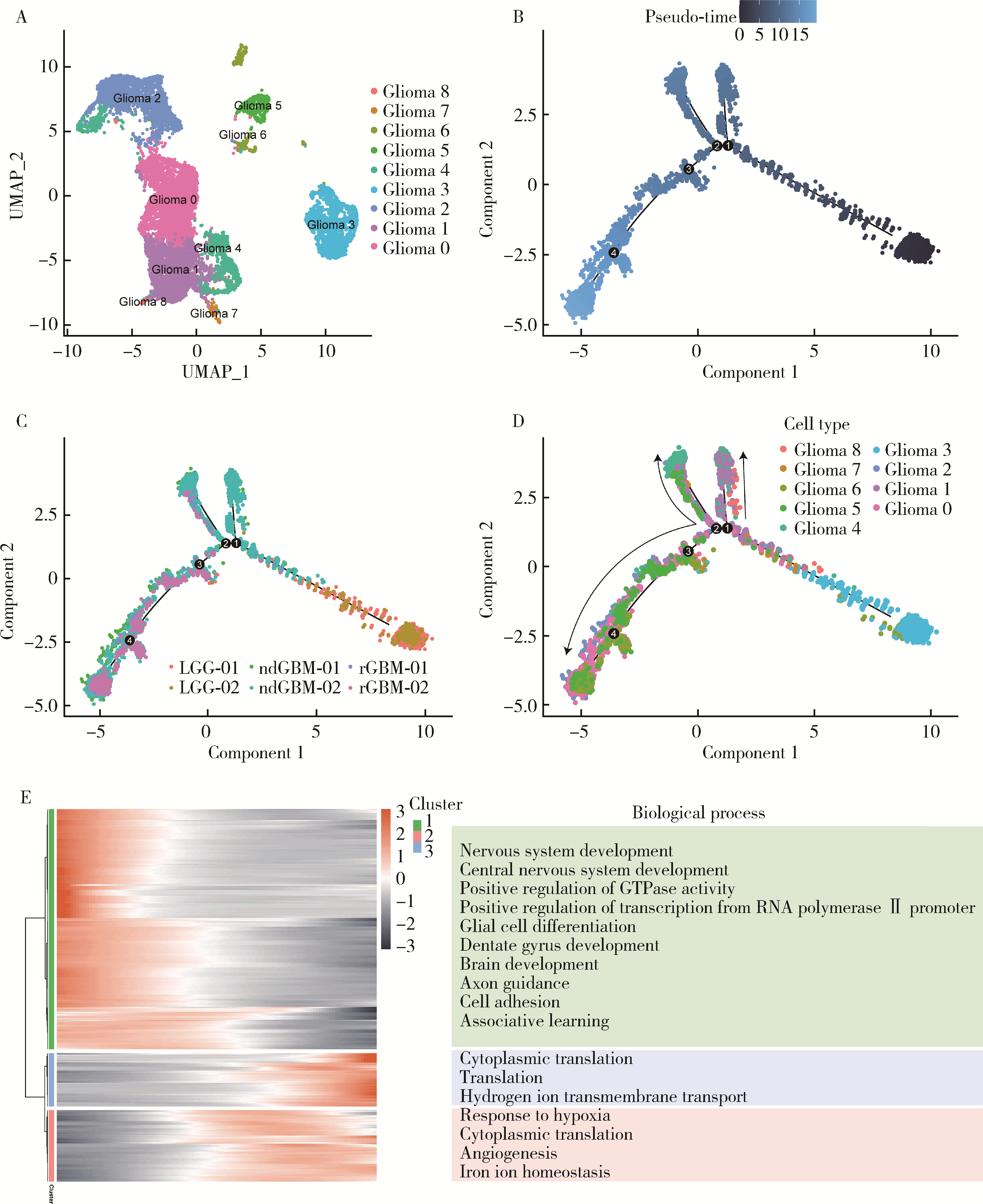Journal of Peking University (Health Sciences) ›› 2024, Vol. 56 ›› Issue (2): 199-206. doi: 10.19723/j.issn.1671-167X.2024.02.001
Dynamic trajectory and cell communication of different cell clusters in malignant progression of glioblastoma
Xiang CAI1,Rendong WANG1,Shijia WANG1,Ziqi REN2,Qiuhong YU2,Dongguo LI1,*( )
)
- 1. Department of Intelligent Medical Engineering, School of Biomedical Engineering, Capital Medical University, Beijing 100069, China
2. Department of Hyperbaric Oxygen, Beijing Tiantan Hospital, Capital Medical University, Beijing 100070, China
CLC Number:
- R739.41
| 1 |
Lee E , Yong RL , Paddison P , et al.Comparison of glioblastoma (GBM) molecular classification methods[J].Semin Cancer Biol,2018,53,201-211.
doi: 10.1016/j.semcancer.2018.07.006 |
| 2 |
Hernández Martínez A , Madurga R , García-Romero N , et al.Unravelling glioblastoma heterogeneity by means of single-cell RNA sequencing[J].Cancer Lett,2022,527,66-79.
doi: 10.1016/j.canlet.2021.12.008 |
| 3 |
Suvà ML , Tirosh I .The glioma stem cell model in the era of single-cell genomics[J].Cancer Cell,2020,37(5):630-636.
doi: 10.1016/j.ccell.2020.04.001 |
| 4 |
Ochocka N , Segit P , Walentynowicz KA , et al.Single-cell RNA sequencing reveals functional heterogeneity of glioma-associated brain macrophages[J].Nat Commun,2021,12(1):1151.
doi: 10.1038/s41467-021-21407-w |
| 5 |
Zhang H , Wang Y , Zhao Y , et al.PTX3 mediates the infiltration, migration, and inflammation-resolving-polarization of macrophages in glioblastoma[J].CNS Neurosci Ther,2022,28(11):1748-1766.
doi: 10.1111/cns.13913 |
| 6 |
Abdelfattah N , Kumar P , Wang C , et al.Single-cell analysis of human glioma and immune cells identifies S100A4 as an immunotherapy target[J].Nat Commun,2022,13(1):767.
doi: 10.1038/s41467-022-28372-y |
| 7 |
Hara T , Chanoch-Myers R , Mathewson ND , et al.Interactions between cancer cells and immune cells drive transitions to mesenchymal-like states in glioblastoma[J].Cancer Cell,2021,39(6):779-792. e11.
doi: 10.1016/j.ccell.2021.05.002 |
| 8 | Liu S , Wang Z , Zhu R , et al.Three differential expression analysis methods for RNA sequencing: Limma, EdgeR, DESeq2[J].J Vis Exp,2021,175,e62528. |
| 9 |
Korsunsky I , Millard N , Fan J , et al.Fast, sensitive and accurate integration of single-cell data with Harmony[J].Nat Methods,2019,16(12):1289-1296.
doi: 10.1038/s41592-019-0619-0 |
| 10 | Slovin S , Carissimo A , Panariello F , et al.Single-cell RNA sequencing analysis: A step-by-step overview[J].Methods Mol Biol,2021,2284,343-365. |
| 11 |
Butler A , Hoffman P , Smibert P , et al.Integrating single-cell transcriptomic data across different conditions, technologies, and species[J].Nat Biotechnol,2018,36(5):411-420.
doi: 10.1038/nbt.4096 |
| 12 |
Cao J , Spielmann M , Qiu X , et al.The single-cell transcriptional landscape of mammalian organogenesis[J].Nature,2019,566(7745):496-502.
doi: 10.1038/s41586-019-0969-x |
| 13 |
Dennis G , Jr Sherman BT , Hosack DA , et al.DAVID: Database for annotation, visualization, and integrated discovery[J].Genome Biol,2003,4(5):P3.
doi: 10.1186/gb-2003-4-5-p3 |
| 14 |
Jin S , Guerrero-Juarez CF , Zhang L , et al.Inference and analysis of cell-cell communication using CellChat[J].Nat Commun,2021,12(1):1088.
doi: 10.1038/s41467-021-21246-9 |
| 15 |
Lin J , Cai Y , Wang Z , et al.Novel biomarkers predict prognosis and drug-induced neuroendocrine differentiation in patients with prostate cancer[J].Front Endocrinol (Lausanne),2023,13,1005916.
doi: 10.3389/fendo.2022.1005916 |
| 16 |
Costa-Silva J , Domingues D , Lopes FM .RNA-Seq differential expression analysis: An extended review and a software tool[J].PLoS One,2017,12(12):e0190152.
doi: 10.1371/journal.pone.0190152 |
| 17 | D'Arrigo G , Leonardis D , Abd ElHafeez S , et al.Methods to analyse time-to-event data: The Kaplan-Meier survival curve[J].Oxid Med Cell Longev,2021,2021,2290120. |
| 18 |
DeCordova S , Shastri A , Tsolaki AG , et al.Molecular heterogeneity and immunosuppressive microenvironment in glioblastoma[J].Front Immunol,2020,11,1402.
doi: 10.3389/fimmu.2020.01402 |
| 19 |
Xiong Z , Yang Q , Li X .Effect of intra- and inter-tumoral heterogeneity on molecular characteristics of primary IDH-wild type glioblastoma revealed by single-cell analysis[J].CNS Neurosci Ther,2020,26(9):981-989.
doi: 10.1111/cns.13396 |
| 20 |
Põlajeva J , Sjösten AM , Lager N , et al.Mast cell accumulation in glioblastoma with a potential role for stem cell factor and chemokine CXCL12[J].PLoS One,2011,6(9):e25222.
doi: 10.1371/journal.pone.0025222 |
| 21 |
Xiong A , Zhang J , Chen Y , et al.Integrated single-cell transcriptomic analyses reveal that GPNMB-high macrophages promote PN-MES transition and impede T cell activation in GBM[J].EBioMedicine,2022,83,104239.
doi: 10.1016/j.ebiom.2022.104239 |
| 22 |
Chen P , Zhao D , Li J , et al.Symbiotic macrophage-glioma cell interactions reveal synthetic lethality in PTEN-null glioma[J].Cancer Cell,2019,35(6):868-884. e6.
doi: 10.1016/j.ccell.2019.05.003 |
| 23 |
Wu C , Qin C , Long W , et al.Tumor antigens and immune subtypes of glioblastoma: The fundamentals of mRNA vaccine and individualized immunotherapy development[J].J Big Data,2022,9(1):92.
doi: 10.1186/s40537-022-00643-x |
| [1] | GENG Qiang, CHEN Hong, REN Jing-Yi, SONG Jun-Xian, LI Su-Fang. microRNA-126 delivered by microparticles mediates intercellular signal transmission [J]. Journal of Peking University(Health Sciences), 2014, 46(6): 894-898. |
|
||







